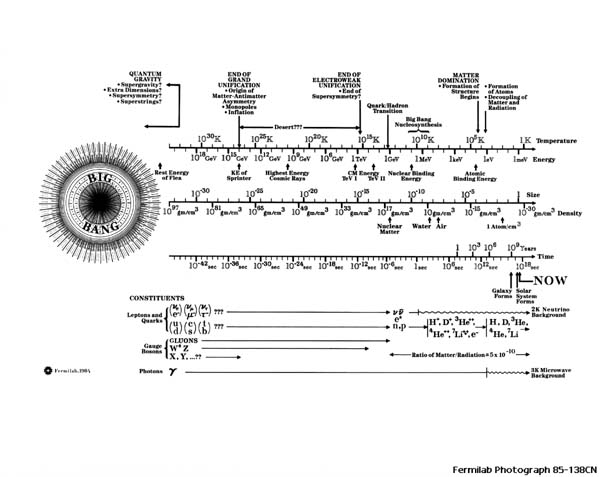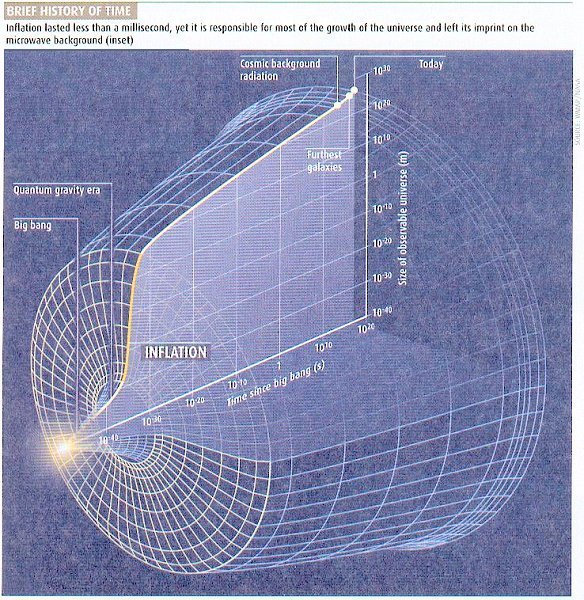Inflatory Universe and phase transitions of early matter: Difference between revisions
RonaldFrey (talk | contribs) No edit summary |
RonaldFrey (talk | contribs) mNo edit summary |
||
| Line 66: | Line 66: | ||
--- | |||
== Acknowledgements and Sources == | |||
1. Dr. Harrison B. Prosper; for indepth discussion, advice, and topic guidance. | |||
2. A Review of the Universe [http://universe-review.ca/R02-13-inflation.htm] | |||
3. Cambridge Cosmology [http://www.damtp.cam.ac.uk/user/gr/public/cs_phase.html] | |||
Latest revision as of 11:26, 5 May 2009
History of Time
Inflation Theory
At a point defined as ~ seconds after the critical beginning, a brief period of exponential expansion known as inflation occurred. This inflation lasted until ~. Before inflation, the size of the universe can be approximated as less than a single proton. After seconds, the universe has expanded to a size of roughly 10 centimeters. This should be alarming as the rate of expansion exceeds the velocity of light, our maximum allowed speed. For comparative purposes, light takes seconds to travel 1 centimeter. The illusion of expanding away from itself faster than the speed of light is corrected for by understanding that no objects are moving faster than light, spacetime itself is expanding at this exceedingly high rate.
The Inflation Field
The driving force of this exponential expansion is termed the "inflation field", for lack of a concise term. Let us discuss a simple example.
We will create a point at the center of the universe, any point will do since any point can be argued the center. Now we consider a sphere of radius R, containing mass M. On the outer edge of this sphere is a test mass m. Now we apply Newton's law of gravitation to see the behavior of our system. Our gravitational potential is a function of the conditions we have set and the gravitational constant G, . Applying a derivative, we calculate the force on our test mass to be . We will take this one step further defining the mass M of our system. We know the volume of the sphere to be and mass is simply the product of volume and density. Therefore, . Substituting back into the equation for gravitational force, . No surprises, we have a test mass m and gravity pulls it attractively with a force proportional to the mass density and square of the distance. The negative sign signifies an attractive force.
We have considered the case of an expanding universe with a constant mass M. Now let us consider the case in which the density is constant. Again we use . This time we will substitute the mass M for our density . We find the force on the test mass to be . The positive sign indicates a repulsive force! In this model, particles are pushed away, allowing the universe to inflate. Upon more careful inspection, notice the only variable parameter is distance R, which increases the force as R increases. This accounts for the exponential rate of expansion during inflation.
It becomes apparent that this model requires the density to remain constant as the volume increases, requiring the addition of more matter. The decay of the "inflation field" into a lower energy state is thought to be responsible for keeping the density constant by providing matter and radiation. Let us go one step more and convince ourselves that we have not committed a regrettable act and no violation of energy has occurred. The kinetic energy may be defined as . Notice how the kinetic energy is exactly opposite the potential energy as defined previously. The total energy remains zero since . The increase in potential is exactly matched by an increase in kinetic. Matter and energy is not being created from nothing, conservation laws are preserved.
Slowing Inflation
At this point the universe is expanding at such a rate, particles are fleeing exponentially rapidly from nearest neighbors. Any organized structures would be impossible to form and our universe would become a very empty place. The weak interaction between quarks would never be able to bind into atoms against the inflation field. A delicate balance between inflation and interaction forces must occur. For this to happen, inflation must slow. At this point, a transition from the inflation field occurs. This is an area of ongoing research and no definitive answer is certain. For completeness a working solution is presented.
The rapid expansion can create localized areas of nucleation. These areas become trapped by boundary conditions such as the bubbles in boiling water. The bubble will contact the wall of another bubble and combine, eventually dissolving the inflation field. However, this model is incomplete. These bubble areas would never combine, instead diverge from other bubbles rapidly so that two will never collide and conjoin. Another mechanism is required. We can define these bubbles as regions of nucleation with boundaries above the energy of the inflation field, similar to a tunnel junction with a particle and a barrier. Energy from the inflation field can tunnel into the bubble, expanding the bubble. The energy lost from the field is converted into radiation/matter and "heats" the bubble causing expansion. Ultimately, the inflation field will decay and the universe can continue to expand a a constant, slower rate.
Phase Transitions
The nucleation of bubbles is a phase transition. The transformation occurs during a very small fraction of time. The type of phase transition is debatable. Bubble nucleation may be gradual as the new phase expands and the old phase disappears. It could also be a much more violent, and spontaneous transition. The best answers are speculation based on the little knowledge we have so far. Until a device is designed to probe energies in excess of K, no theory can be proved correct.
Shortly after the big bang, the 4 fundamental forces were perfectly symmetric. Electromagnetism, strong nuclear force, weak nuclear force, and gravity could be described as united and indistinguishable. As the temperature of the universe cools, a second order phase transition occurs. At ~K gravity becomes distinct. The electroweak force separates into electromagnetism and the weak nuclear force at ~300-1000GeV, corresponding to a temperature of ~K. Once these thresholds are crossed, the symmetry is spontaneously broken and the force drops out of unity. The phases are described mathematically as G -> H -> ... -> SU(3) x SU(2) x U(1) -> SU(3) x U(1).
Something From Nothing
Our current understanding in the scope of the universe is not even comparable to a grain of sand at the beach. Science is advancing quickly, yet the journey has just begun. We have no reproducible data and conclusions are merely inferred from the observable universe. In the coming years, we hope to probe the conditions during which the electroweak broke down into constituent forces. The Large Hadron Collider is expected to produce energies on the scale necessary and shed some light on how our universe began. We hope to understand how these forces unify, how symmetry is broken, understand the phase transitions, and open new doors to the future. Even so, this is a simple beginning.
Acknowledgements and Sources
1. Dr. Harrison B. Prosper; for indepth discussion, advice, and topic guidance.
2. A Review of the Universe [1]
3. Cambridge Cosmology [2]



















